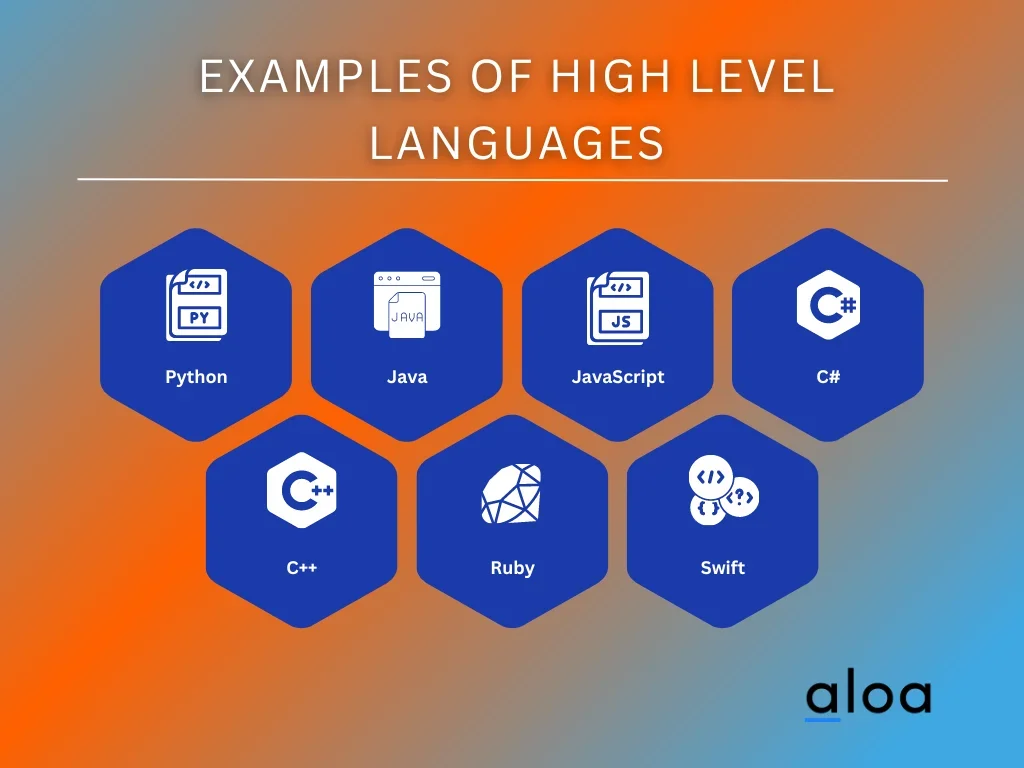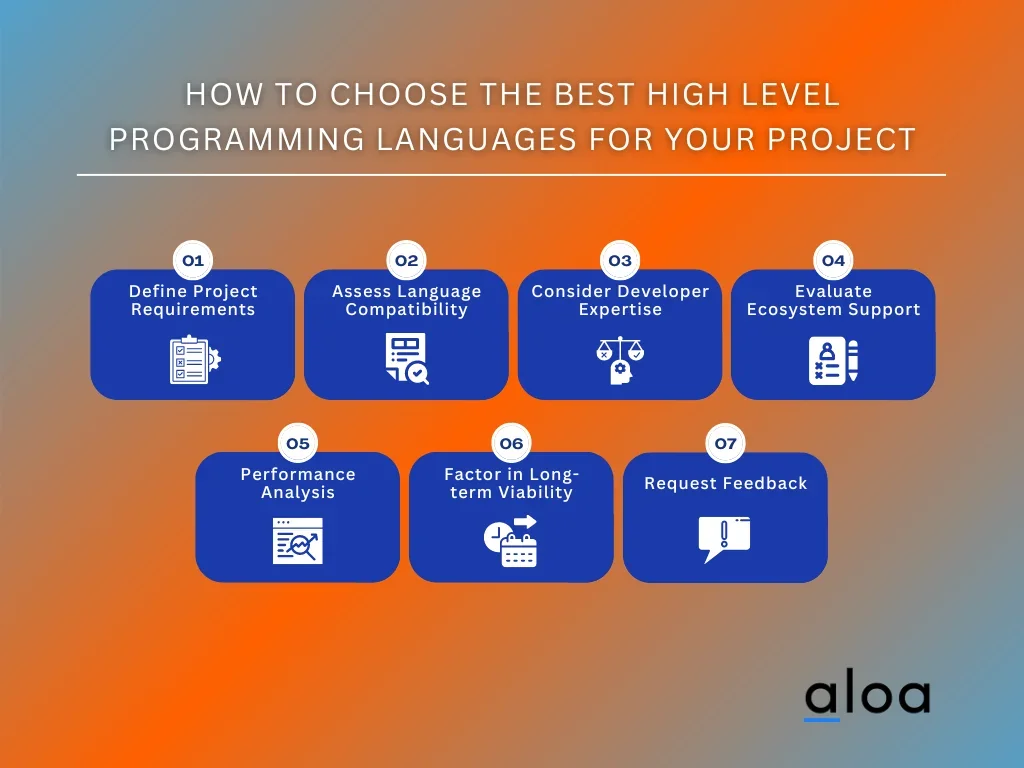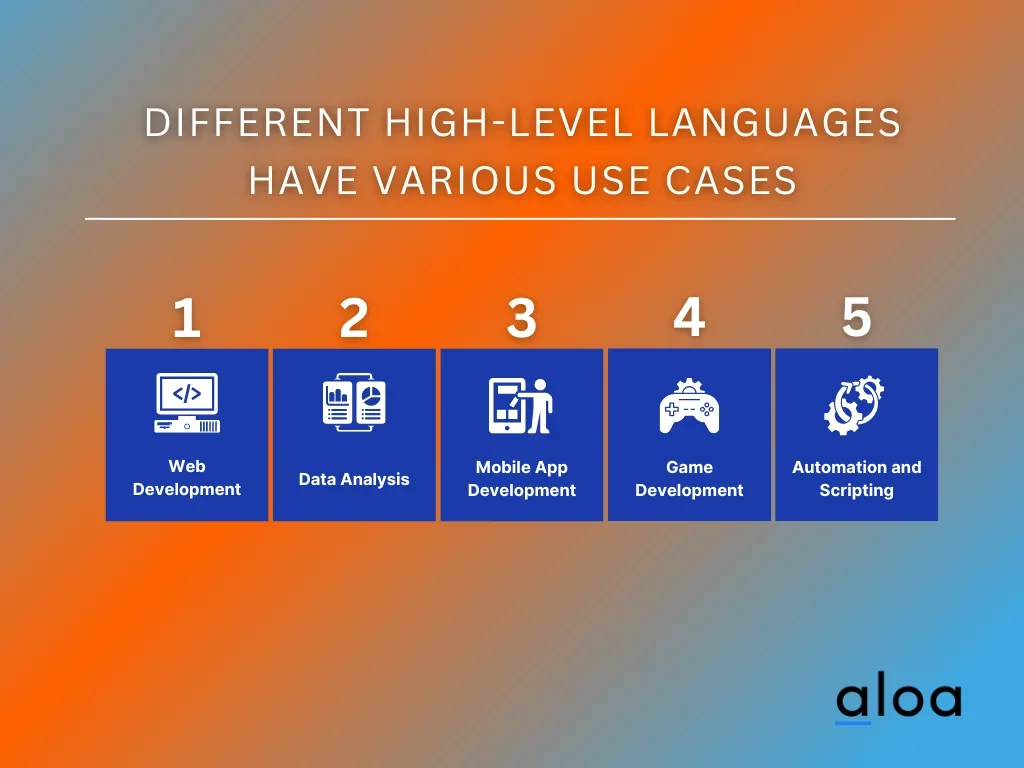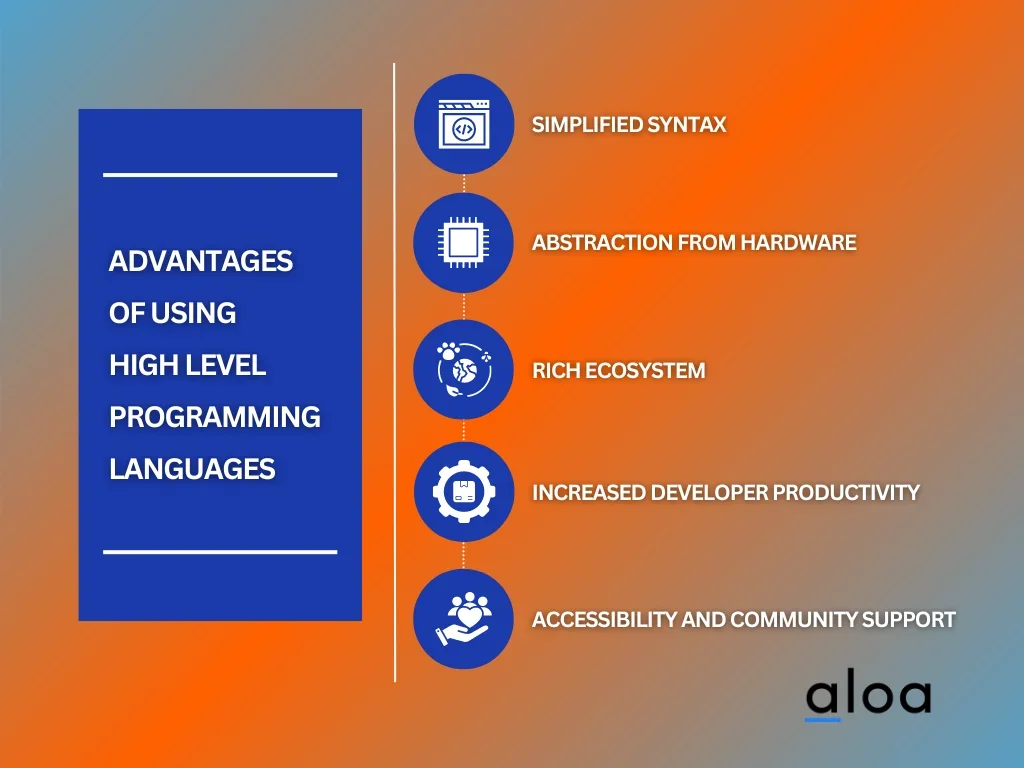High level programming languages are the backbone of modern software development, offering a bridge between human logic and machine execution. These computer programming languages simplify coding tasks for developers of all levels. With their versatility, readability, and extensive ecosystems, high-level programming languages continue to drive the evolution of technology and shape the digital landscape.
At Aloa, a software outsourcing firm, we specialize in delivering tailored solutions to meet our client’s diverse needs. Our rigorous vetting process ensures we only collaborate with experts proficient in high-level and low-level language. This expertise positions us as industry leaders in facilitating successful partnerships between businesses and skilled developers.
Drawing from our extensive expertise, we’ve compiled this guide to provide insights into different types and uses of high level programming languages. Our experience spans popular programming languages like Python, JavaScript, and Ruby, enabling us to understand their strengths and weaknesses. From that experience, you’ll have a deep understanding of various programming languages that can make your coding journey easier.
Let’s delve in!
What are High Level Programming Languages?
High level programming languages refer to coding languages that are designed to be more intuitive and user-friendly for human programmers. They abstract away low-level details of computer hardware to make coding more accessible. These languages typically have simpler syntax and require fewer lines of code than low-level languages.
Additionally, higher-level languages provide a significant level of abstraction from machine language, enabling developers to focus on solving complex problems. With their extensive documentation and community support, these languages aid programmers in streamlining their software and application development.
Examples of High Level Languages
High level programming languages are widely used in various fields of computer science and software development. They offer developers the flexibility and convenience to build various applications. Some of the most popular programming languages include:

- Python: Renowned for its simplicity, versatility, and strong emphasis on code readability, Python is widely favored in various fields such as web development, data analysis, and artificial intelligence. Its clean syntax and extensive libraries contribute to its ease of use, making it a top choice for developers across different domains, including those who utilize Replit Python.
- Java: Java is frequently utilized in enterprise-level applications, Android app development, big data tools, large-scale systems, and functional programming languages. Its robust ecosystem and extensive community support make Java a dependable choice for Java developers.
- JavaScript: Primarily used for web development, JavaScript powers dynamic and interactive website features, making it essential for front-end and back-end development. Its flexibility and compatibility with frameworks like React and Node.js have made it a cornerstone of modern web development.
- C#: Developed by Microsoft, C# is favored for building Windows applications, web services, games using Unity, and enterprise software solutions. You might want to hire C developers if you are looking for robust typing systems and easy integrations with the .NET framework. This also makes it popular for building robust and scalable applications.
- C++: Renowned for its performance and flexibility, C++ is a go-to for game development, system programming, and performance-critical applications among C++ developers. Its ability to directly manipulate hardware and manage memory makes it a powerful tool for building high-performance applications.
- Ruby: Prized for its simplicity and productivity, Ruby is often chosen for web development, particularly with the Ruby on Rails framework. Its elegant syntax and focus on developer satisfaction have made it a favorite among startups and established companies.
- Swift: Swift offers modern syntax and performance enhancements for building Apple ecosystem apps. Its safety features and interoperability with Objective C make it a preferred choice for developing native iOS and macOS applications.
Understanding these high level programming languages provides a glimpse into the wide range of tools that are available to developers.
How To Choose the Best High Level Programming Languages for your Project
With various options available, selecting the best high level programming language for your project can be daunting. However, by following a systematic approach, you can make an informed decision that aligns with your project’s requirements and goals. Here, we outline the steps to navigate this process effectively and choose the optimal language for your project’s success.

Step 1: Define Project Requirements
Defining project requirements is the crucial first step in selecting the best high level programming language for your project. Start by outlining your project’s objectives, scope, and expected outcomes to establish clear goals. Afterward, identify any specific functionalities, performance criteria, or compatibility requirements for achieving project success.
You may also consider factors such as target platform, scalability, and integration with existing systems to ensure compatibility with your project’s environment. Be sure that stakeholders, developers, and other individuals are involved in gathering the requirement process to cater diverse perspectives and ensure comprehensive coverage of project needs.
Step 2: Assess Language Compatibility
Assessing language compatibility entails scrutinizing how effectively a programming language aligns with the technical requirements of your project, considering both control and data structures. This evaluation is pivotal to circumvent potential limitations or mismatches between the language's capabilities and project needs. Failing to figure this out could impede development progress or lead to suboptimal outcomes.
Here are the considerations to take in assessing language compatibility:
- Platform Support: Determine whether the language supports the platforms and operating systems relevant to your project to ensure seamless deployment and compatibility.
- Performance Requirements: Evaluate the language’s performance characteristics, including execution speed, memory usage, and scalability, to ensure it can meet the project’s performance demands efficiently.
- Library and Framework Availability: Consider the availability of libraries, frameworks, and third-party tools associated with the high level programming language, as they can significantly impact development productivity.
- Integration with Existing Systems: Determine whether the language can integrate seamlessly with any existing systems, databases, or technologies already used within your project environment.
Step 3: Consider Developer Expertise
Consideration of developer expertise is paramount when choosing among the best high level programming languages for your project. To do that, assess the proficiency and familiarity of your development team with different languages to ensure they can effectively utilize each language’s features and capabilities.
Once done, match the language to your team’s expertise so you can enhance productivity and reduce learning curves. Doing this ensures you can have faster development cycles and improved code quality. Additionally, leveraging your team’s existing skills and knowledge can foster collaboration and teamwork, as developers can share insights and best practices within a familiar framework.
Step 4: Evaluate Ecosystem Support
Evaluating ecosystem support involves assessing the availability and quality of resources, libraries, and tools within the programming language’s ecosystem. This evaluation helps determine the level of community engagement, documentation, and development resources available to support developers in their projects.
Here are a few considerations to take when evaluating ecosystem support
- Community Engagement: Assess the activity and engagement of the language’s community, including forums, discussion groups, and open-source contributions, as an active community fosters collaboration and support.
- Documentation Quality: Evaluate the quality and comprehensiveness of the language’s documentation and official resources, as well as document libraries and tutorials, which can significantly ease the learning curve for developers.
- Development Tools: Consider the availability of development tools, integrated development environments (IDEs), and package managers tailored to the language, which can enhance productivity and streamline the development process.
- Long-Term Support: Examine the language’s roadmap, release cycles, and ongoing development efforts to gauge its long-term viability and ensure continued support and updates for future projects.
Step 5: Analyze Performance Considerations
Analyzing performance considerations involves assessing how efficiently a high level programming language can execute tasks and utilize system resources. This evaluation typically involves measuring various factors to ensure the language can meet the performance requirements of your project.
Below are the crucial factors to consider:
- Execution Speed: Evaluate the language’s execution speed for critical operations, such as mathematical calculations or data processing, to ensure optimal performance.
- Memory Usage: Assess the language’s memory consumption to determine its efficiency in managing system resources, avoiding excessive memory leaks or overhead.
- Scalability: Consider the language’s ability to scale with increasing workload or user demand, ensuring it can handle growing data volumes or concurrent users effectively.
- Concurrency Support: Evaluate the language’s support for concurrent programming paradigms, such as multithreading or asynchronous processing, to efficiently utilize available hardware resources.
- Optimization Tools: Explore the availability of profiling and optimization tools for the language, enabling developers to effectively identify and address performance bottlenecks during the development and testing phases.
Step 6: Factor in Long-term Viability
Factor in long-term viability involves assessing a programming language’s sustainability and future prospects for your project’s needs. This evaluation considers different factors to ensure that the chosen language remains viable and well-supported in the long run.
Here are the considerations to take when evaluating long-term viability:
- Language Evolution: Regular updates, new features, and improvements demonstrate a language’s commitment to innovation and relevance to ensure it remains competitive and capable of addressing emerging challenges.
- Adoption Trends: Monitoring a language’s adoption trends and popularity within the industry provides insights into its staying power and potential for continued growth and support.
- Industry Relevance: Consider the language’s relevance and usage across different industries and domains, as widespread adoption and industry support contribute to its stability and long-term viability.
- Backward Compatibility: High level programming languages that prioritize backward compatibility ensure smooth transitions between versions and minimize disruptions to existing projects.
Step 7: Seek Feedback and Recommendations
Seeking feedback and recommendations involves consulting with colleagues, industry peers, and online communities to gather insights and experiences with different high level programming languages. This step is essential because it provides valuable perspectives and recommendations from individuals with diverse backgrounds and experiences to help you make an informed decision.
Additionally, feedback from experienced developers can offer insights into language suitability, best practices, and potential pitfalls, ultimately guiding you toward selecting the most suitable language for your project.
Example Use Cases for the Different Types of High Level Programming Languages
High level programming languages are versatile tools that find application across various software development domains. They empower developers to tackle diverse challenges, from web development to data analysis.
Here are some use cases of high level programming languages with a sample language that exemplifies various sectors:

Web Development
Web development involves building websites and web applications for various purposes, such as e-commerce, social networking, and content management systems. HTML, CSS, JavaScript, and Python are the top web development languages used in these tasks.
Such languages empower web developers to craft dynamic and interactive web pages, design stylish layouts, and seamlessly implement client-server interactions within the web browser environment.
Data Analysis
Data analysis encompasses examining, cleaning, transforming, and interpreting data to extract meaningful insights and make informed decisions. High-level programming languages like Python and R are widely used. With libraries like Pandas, NumPy, and SciPy (Python), analysts can efficiently manipulate data, perform statistical analysis, and visualize results to derive valuable insights.
Mobile App Development
Mobile app development involves creating applications designed to run on mobile devices like smartphones and tablets. High-level programming languages like Java, Kotlin (for Android), and Swift (for iOS) are commonly used in mobile app development. These languages and their respective development environments and frameworks enable developers to build native apps with rich user interfaces and seamless performance.
Game Development
Game development encompasses designing, developing, and deploying video games for various platforms such as consoles, PCs, and mobile devices. High level programming languages like C++, C#, and JavaScript is often used in this development. Additionally, game engines such as Unity (C#), Unreal Engine (C++), and Phaser (JavaScript) help developers create visually stunning graphics and optimize performance for immersive gaming experiences.
Automation and Scripting
Automation and scripting language involve writing scripts or programs to automate repetitive tasks, streamline workflows, and simplify system administration processes. Most popular languages like Python, Bash, and PowerShell are commonly used for automation and scripting. These languages offer extensive libraries, built-in modules, and command-line interfaces to allow developers to automate data processing, system monitoring, and software deployment tasks efficiently.
Advantages of Using High Level Programming Languages
High level programming languages offer numerous benefits that simplify the development process and enhance productivity. With their user-friendly syntax and built-in features, these languages enable developers to write code more efficiently and focus on solving higher-level problems. Let’s find out some of the advantages of using these languages.

Simplified Syntax
High-level programming languages offer simpler syntax and structures than low-level languages. This helps reduce the complexity of coding tasks and make it easier for developers to write and understand code efficiently. Having this simplicity increases productivity and shorter development cycles, as programmers spend less time wrestling with intricate language intricacies.
Abstraction from Hardware
High level programming languages abstract away the details of hardware architecture, allowing developers to focus on solving higher-level problems. With this benefit, developers can efficiently write code without worrying about low-level memory management or processor instructions. This abstraction enhances portability, as code written in high level languages can be easily adapted to different platforms and environments without significant modifications.
Rich Ecosystem
High level programming languages typically boast extensive libraries, frameworks, and tools that streamline development and provide solutions for everyday tasks. This rich ecosystem accelerates the development process by providing pre-built components and functionalities, allowing developers to leverage existing solutions rather than repeating work.
Increased Developer Productivity
High level languages enhance developer productivity by automating repetitive tasks, offering built-in features, and providing intuitive syntax. This positive nature enables programmers to accomplish more in less time. Simply put, it offers productivity that translates into faster project delivery, reduced time-to-market, and, ultimately, cost savings for businesses.
Accessibility and Community Support
High level programming languages often have large and active developer communities that offer resources, documentation, tutorials, and support forums to help programmers overcome challenges and learn new skills. This accessibility fosters collaboration, knowledge sharing, and continuous improvement within the developer community. Compiling it up, it contributes to the widespread adoption and evolution of high-level languages.
Key Takeaway
Understanding the different high level programming languages requires a strategic approach. Carefully considering your project’s requirements and seeking input from experts can help grasp their nuances and allows you to make informed decisions for your development journey. Remember, choosing the correct language isn’t just about writing code; it’s about setting the stage for innovation, efficiency, and long-term project success.
So, take the time to explore your options and leverage your resources to propel your projects to new heights. With dedication and intelligent choices, you’ll build great software and cultivate a foundation for continuous growth and advancement in the ever-evolving programming field.
Want to learn more about different high level programming languages? Explore the Aloa blog page for additional insights into selecting the language that aligns with your project goals. Our resources are designed to empower you with knowledge and strategies to ensure your projects succeed and thrive in today’s competitive software landscape.

